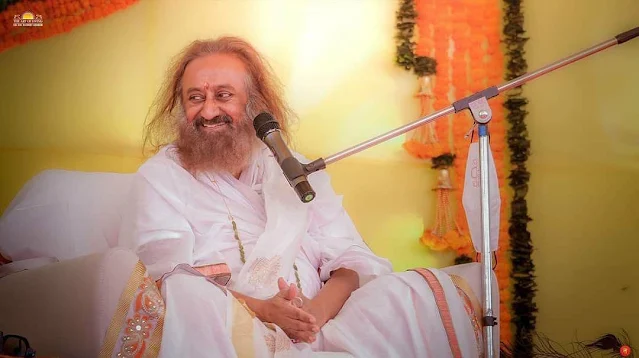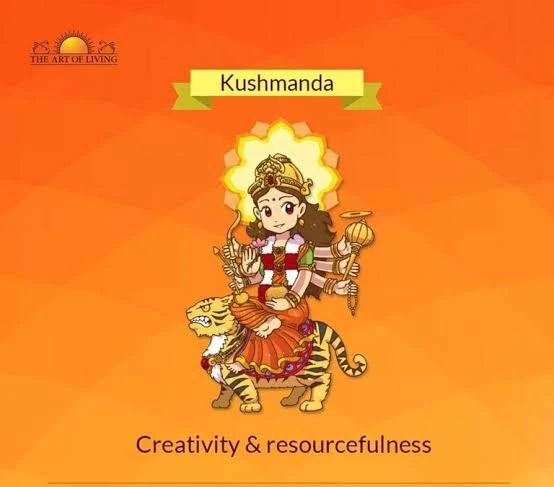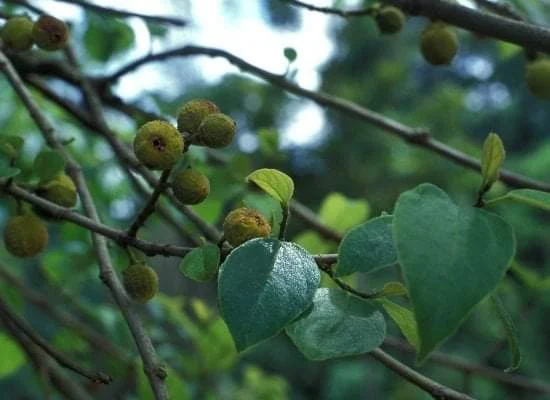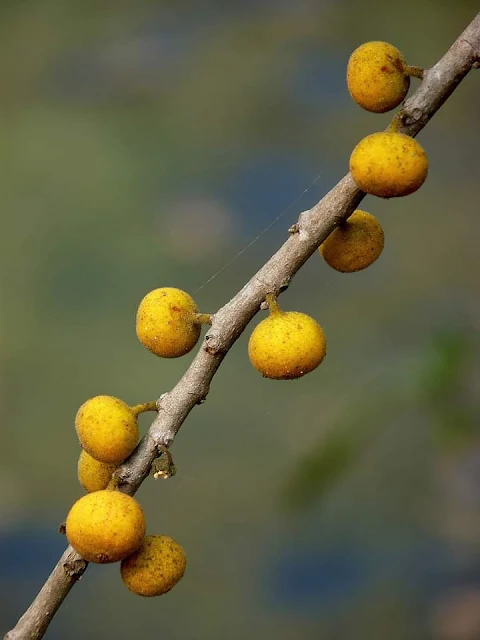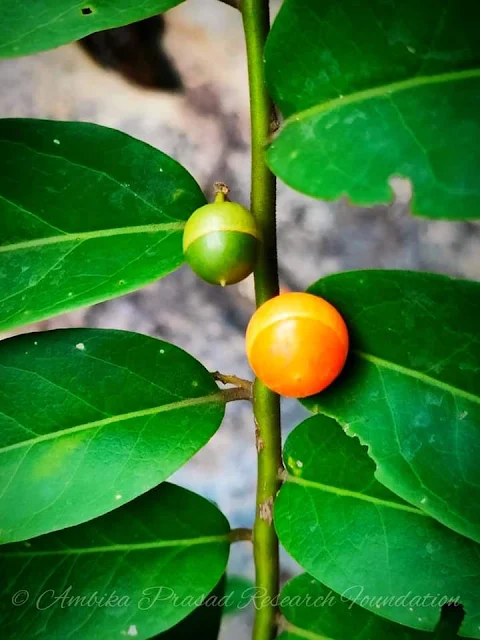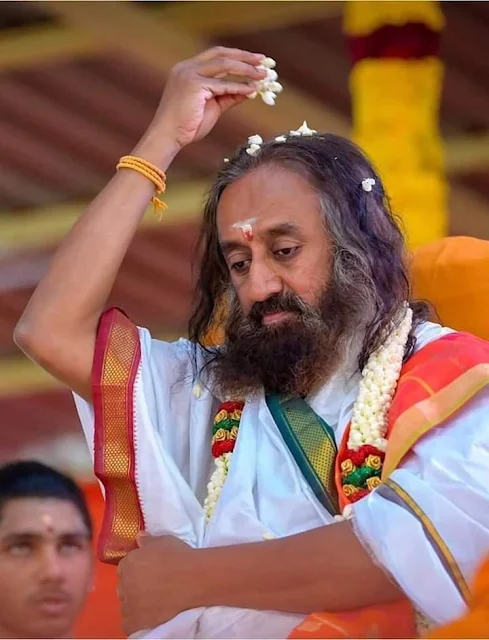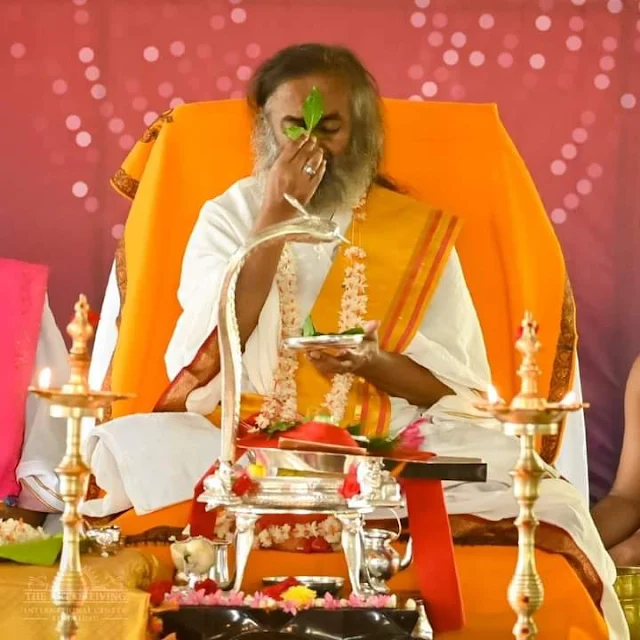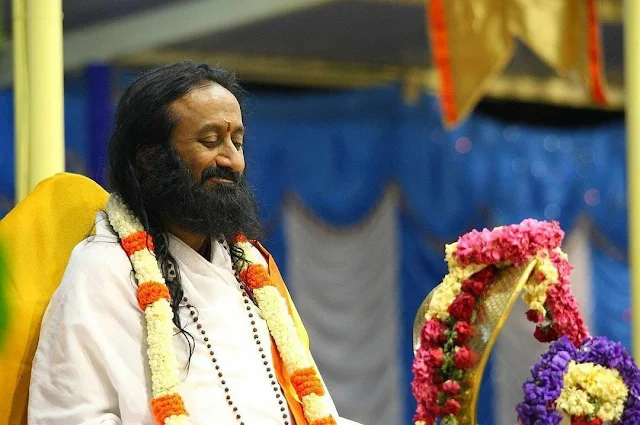Ayurveda , Doctor , Treatment , Medicine , Pure Herbs ,Yoga , Meditation... ...Rejuvenate yourself with Ayurveda and Yoga
Gurudev, how to bring my children who oppose coming onto this beautiful spiritual path?
On the fourth day of Navratri, the Mother Divine is worshipped in the form of Kushmanda Devi.
Ficus asperrima Roxb, Ficus punctifera Warb, Ficus scabra Willd, Ficus serrata Forssk, Ficus silicea Sim. Its vernacular names in India are: Gargatti Aalada Mara, ಅಡವಿ ಅತ್ತಿ Adavi Atti, ಗರಗತ್ತಿ Garagatti in Kannada; Parakam or Therakam in Malayalam; Karvat करवत in Marathi; करपत्र Karapatra in Sanskrit; Irambarattam or Maramthinni Atthi in Tamil; Karaka Boddu కరక బొద్దు or Karasana or Siri Bodda in Telugu. It is also called Brahma's Banyan.
- Narasipur Char
Udumbara or Umbar tree or Audumbara tree (Ficus glomerata) is one of the cosmic trees of India which is known since Vedic times due to its religous siginficance but also due to its peculiar and useful quality and also partly due to its healing and medical powers?
Olax scandens Family : Olacaceae Habit : Shrub Habitat : dry to moist areas
Let us not hate each other. What can really block your progress is hatred
“let the Divine protect us both. Let us be together. Let us develop our ability together. Let us be effulgent, brilliant. Let us not hate each other”.
whatever you do, you will do it happily. Whether sitting, walking, smiling, bathing or taking food, it will bring you happiness. No matter what you do, this happiness will never leave. The peak of life is this Shivatattva.
Our sense organs are spectators. Our sense organs are spectators. This is an amazing sutra. The whole drama that is happening in the world is witnessed by our senses.
Gurudev, how to overcome the fear of losing my loved ones?
Ultimately, I made my choice and it worked out extremely perfectly. It was all done with so much grace. I received such clarity of mind after meeting Guruji. It was all that I needed and he knew it.
Sri Sri Tattva Medicine | YOUR WELLNESS CENTRE C 124, Vashi Plaza, Sector 17, Vashi, Navi Mumbai 400703 Tel: 9089086363
Sri Sri Tattva Ayurvedic Proprietary Medicine , Single Herbs and Classical Medicine at Glance to Promote Health and Wellness
NAOQ19
AMLAPITTARI VATI ,
AMRUTADI VATI ,
ANCHOLEAN TABLETS,
ATISARAHARA VATI ,
DEVA VATI ,
IMMUGEN TABLETS,
JANTUGHNA VATI ,
JVARA KEERTI VATI ,
KASAHARA VATI ,
LIV-ON TABLETS,
MAMATVA GRANULES ,
MEHANTAKA VATI ,
NARAYANA KALPA TABLET ,
NAVAHRIDAYA KALPA TABLETS,
OORJA FORTE TABLETS,
OORJA TABLET ,
OSPO-C TABLETS ,
PAVANAHARA VATI ,
PITTA BALANCE GRANULES ,
PRADARASHAMAKA VATI ,
PRANADA GUTIKA ,
PRATISHYAYAHARA VATI ,
PYLMUKTI OINTMENT ,
PYLMUKTI TABLET ,
QUICK HEAL CREAM ,
RAKTASHODHINI VATI ,
RAKTAVARDHINI TABLET ,
RAKTAVARDHINI SYRUP ,
SANDHIMITRA VATI ,
SHIRASHOOLARI VATI ,
SHWASA SHUDDHI VATI ,
TWAQURE OINTMENT ,
VEDANANTAKA BALM ,
VEDANANTAKA LINIMENT ,
VEDANANTAKA VATI ,
VIRECHANA VATI ,
VRIKKA SANJIVANI VATI ,
VITILWEL OINTMENT ,
VITILWEL TABLETS ,
AMLA TABLETS ,
AMRUTH TABLETS ,
ARJUNA TABLETS ,
ASHWAGANDHA TABLETS ,
ASHWAGANDHADI TABLETS ,
BRAHMI TABLETS ,
CHANDRAPRABHA VATI ,
CHITRAKADI GUTIKA TABLETS ,
DHATRI LAUH TABLETS ,
HARITAKI TABLETS ,
KAMADUDHA RASA TABLETS ,
KAPIKACCHU GRANULES ,
LAVANGADI VATI ,
NAVAYASA LAUHA TABLETS ,
NEEM TABLETS ,
NISHAMALAKI TABLETS ,
RASNADI VATI ,
SAPTHAMRUTH LAUHA TABLETS ,
SHATAVARI TABLETS ,
SHILAJIT LAUHA VATI ,
SUDARSHAN VATI ,
TRIPHALA TABLET ,
TULASI TABLET ,
VYAGHRYADI TABLET ,
YASHTIMADHU TABLET ,
GOKSHURADI GUGGULU ,
KANCHANARA GUGGULU ,
MAHAYOGRAJ GUGGULU ,
TRAYODASHANGA GUGGULU ,
AVIPATTIKARA CHURNA ,
HARIDRA KHANDA ,
HINGVASTAKA CHURNA ,
PAVANHARA CHURNA ,
SITOPALADI CHURNA ,
TALISADI CHURNA ,
TRIPHALA CHURNA ,
BRAHMA RASAYANA ,
CHITRAKAHARITAKI LEHYA ,
KUSHMANDA RASAYANA ,
NASYA NASAL INHALER ,
SRINETRA STERILE EYE DROPS,
SUDANTA TOOTH DROPS ,
KASAHARI COUGH SYRUP ,
MEDHYA RASAYANA SYRUP ,
PACHANI RASAYANA SYRUP ,
PRADARASHAMAKA SYRUP ,
RAKTASHODHINI ARISHTA ,
SARIVA SYRUP ,
USHIRA SYRUP ,
MAHATRIPHALADYA GHRITA ,
PHALASARPI ,
GOMUTRA ARKA ,
GULMAHARA ARKA ,
ORGANIC AJAMODA ARKA ,
ORGANIC TULASI ARKA,
SANDHIMITRA ARKA,
SHAKTI DROPS,
VRIKKA SANJIVANI ARKA ,
ANU TAILA,
KSHIRABALA TAILA,
NARAYANA TAILA,
PINDA TAILA,
SHISHU TAILA ,
OJASVITA RAGI,
PRADARSHAMAKA VATI,
ALOE VERA JUICE ,
AMLA JUICE,
ALOE VERA TRIPHALA JUICE,
KARELA JAMUN JUICE
KABASURA KUDINEER TABLETS,
KABASURA KUDINEER CHOORNAM ,
TURMERIC PLUS TABLETS ,
GILOY JUICE ,
GILOY TULASI JUICE
AYUSH KWATH TABLETS ,
SUDANTA TABS ,
AYUKANTI LEHYAM ,
OJASVITA GOLDEN LATTICE .
KALAMEGH TABLETS ,
AYUSH - 64 ,
SHANKHPUSHPI TABLETS ,
SUKESHA KALPA TABLETS ,
SUKESHA HAIR VITALISER CREAM ,
Giloy juice
Giloy Tulasi Juice
CHYAWANPRASH ,
ALMOND OIL VEG CAPSULE ,
EVENING PRIMROSE OIL VEG CAPSULE ,
FENUGREEK OIL VEG CAPSULE ,
FLAXSEED OIL VEG CAPSULE ,
GARLIC OIL VEG CAPSULE ,
NIGELLA OIL VEG CAPSULE ,
WHEAT GERM OIL VEG CAPSULE ,
APPLE CIDER VINEGAR JUICE ,
WHEATGRASS JUICE ,
MOORINGA JUICE ,
RAW NONI JUICE ,
Gurudev, Can we alter our Time of Death by taking better care of ourselves and by praying? Or is it that when it’s time to go, we have to go? Is it true that no one can alter that?
Rejuvenate yourself with Ayurveda and Yoga Campaign
Popular Posts
-
Yog of Knowledge and Action Chapter 4, Verse 35 yaj-jñātvā na punar-moham evam yāsyasi pāṇḍava yena bhūtāny-aśeṣeṇa drakṣyasy-atman-y...
-
Meditation Yoga Chapter 6, Verse 17 yuktāhāra vihārasya yukta ceṣṭasya karmasu yukta svapnāvabodhasya yogo bhavati duḥkha-hā Yoga becomes th...
-
A story told by Sai Baba: Every action has consequences Premachand is an eminent and well-known Hindi writer. Both of his sons studied in Al...
-
Meditation Yoga Chapter 6, Verse 18 yadā viniyataṁ cittam ātmany-evāvatiṣṭhate niḥspṛhaḥ sarva-kāmebhyo yukta ity-ucyate sadā When all the m...
-
Meditation Yoga Chapter 6, Verse 1 śrī bhagavān uvāca anāśritaḥ karma-phalaṁ kāryaṁ karma karoti yaḥ sa saṁnyāsī ca yogī ca na nir-agn...
-
DR MAHESH D PATIL B.A.M.S.( MUMBAI) PG DIPLOMA NUTRITION ( DELHI ) CERTIFICATE IN PAEDIATRIC NUTRITION ( IAPEN MEMBER ) PG DIPLOM...
-
AYURVEDA GOD LORD DHANVANTRY DR YOJANA U NAPHADE B.A.M.S LAXMI CLINIC OPP.SWAMI VIVEKANAND SCHOOL RAMCHANDRA NAGAR DOMBIVLI EA...
-
Solanum nigrum (Common Name: Black nightshade, Makoi) – Solanaceae, a common herb or short-lived perennial shrub. ...
-
Karma Sanyasa Yoga Chapter 5, Verse 26 kāma krodha viyuktānāṁ yatīnāṁ yata-cetasām abhito brahma-nirvāṇaṁ vartate viditātmanām To tho...




